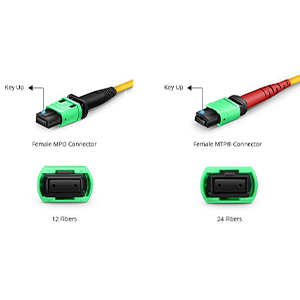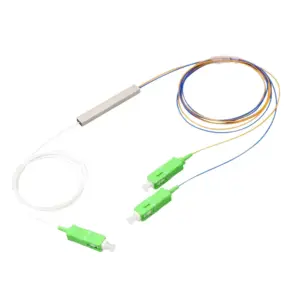Polarization maintenance plays a key role in fiber optic communications. This article will explore the characteristics and applications of polarization-maintaining fiber splitters. We will first define the basic structure and working principle of polarization-maintaining fiber splitters and explain how they differ from ordinary fiber splitters. Next, we will analyze in depth the main features of polarization-maintaining fiber splitters, including maintaining the polarization state of light waves, suppressing polarization mode dispersion, excellent isolation performance, providing precise polarization control, and high reliability and stability.
We will explain how these features improve the performance of optical communication systems. Subsequently, we will analyze the use of polarization-maintaining fiber splitters in typical application scenarios such as lasers and optical sensors, and explain their key role in each application. Finally, we will provide key indicators and selection recommendations to consider when selecting polarization-maintaining fiber splitters.
What is a polarization-maintaining fiber splitter
Let me introduce you to the definition and characteristics of a polarization-maintaining fiber splitter:
Definition of a polarization-maintaining fiber splitter:
- A polarization-maintaining fiber splitter is an optical splitter that uses polarization-maintaining fiber as a transmission medium
- It can separate the input polarized light into two orthogonally polarized output lights
- In addition to the polarization-maintaining fiber itself, the splitter also includes special polarization separation components
Structure and working principle of a polarization-maintaining fiber splitter:
- The core of a polarization-maintaining fiber splitter is to use polarization-maintaining fiber as a transmission medium
- By introducing stress or geometric anisotropy in the polarization-maintaining fiber, the two orthogonal polarization modes of light have different propagation constants
- At the input end, the input light is separated into two orthogonally polarized output lights by a special polarization separation element
- This orthogonal polarization separation is the key function of the polarization-maintaining fiber splitter
Difference from ordinary fiber splitters:
- Ordinary fiber splitters are isotropic and cannot control the polarization state
- The polarization state of the output light will change randomly and cannot be predicted
- And the polarization-maintaining fiber splitter can stably separate the orthogonally polarized output light
- This precise control of the polarization state of light is the unique advantage of the polarization-maintaining fiber splitter
In short, the polarization-maintaining fiber splitter can achieve precise separation and control of the polarization state of light waves by utilizing the anisotropy of the polarization-maintaining fiber, which is the main difference between it and ordinary fiber splitters. This unique feature makes the polarization-maintaining fiber splitter play an important role in certain professional applications with strict polarization requirements.
Main features of polarization-maintaining fiber splitter
Let me introduce you to the main features of polarization-maintaining fiber splitter in detail:
Maintain the polarization state of light waves:
- Polarization-maintaining fiber splitter uses polarization-maintaining fiber as the transmission medium
- Through the special internal structure design, the polarization state of light waves can be effectively maintained
- The output light maintains good polarization characteristics and will not change randomly due to splitting
- This polarization stability is very important for polarization-sensitive optical communication systems Crucial
Suppressing polarization mode dispersion:
- Ordinary fiber splitters have polarization mode dispersion (PMD) problems
- Polarization-maintaining fiber splitters can effectively suppress PMD and reduce this distortion factor
- PMD suppression ensures the quality of optical signals in high-speed and long-distance transmission
- Greatly improves the transmission performance of the entire optical communication system
Excellent isolation performance:
- Polarization-maintaining The fiber splitter has extremely high isolation between the ports.
- This excellent isolation performance ensures the independence of each output signal.
- Avoids mutual interference between ports and improves system reliability.
Provides precise polarization control:
- Polarization-maintaining fiber splitters can accurately control and separate the polarization state of light waves.
- This precise polarization control is important in applications with strict polarization requirements.
- It can meet the requirements of various professional optical applications. Stringent requirements for polarization state
High reliability and stability:
- The polarization-maintaining fiber splitter itself has excellent reliability and stability characteristics
- These characteristics help to improve the reliable operation and service life of the entire optical system
- Greatly improve the stability and risk resistance of the system
In short, the polarization-maintaining fiber splitter plays an important role in professional optical communications, optical measurement and other fields with its unique functional advantages. It is an optical splitting device with excellent performance.
Introduction to the application scenarios of polarization-maintaining fiber splitters
Let me introduce you to the use of polarization-maintaining fiber splitters in typical application scenarios:
Laser applications:
- Polarization-maintaining fiber splitters are widely used in the optical path distribution of high-power lasers
- It can effectively separate orthogonally polarized laser beams
- These orthogonally polarized beams can be used for applications such as dual-beam interference
- Polarization of polarization-maintaining fiber splitters Stability is the key to laser system performance
Optical sensing applications:
- Various optical fiber sensors based on polarization-maintaining fiber require polarization-maintaining fiber splitters
- Polarization-maintaining fiber splitters can be used to separate orthogonal polarization components of sensing light waves
- The separated polarization components can be used to measure strain, temperature, torsion, etc.
- The high isolation of polarization-maintaining fiber splitters ensures high accuracy of sensors
Optical Communication applications:
- In high-speed optical communication, polarization-maintaining fiber splitters can effectively suppress PMD.
- PMD is one of the key factors limiting communication capacity and distance.
- The PMD suppression characteristics of polarization-maintaining fiber splitters improve the performance of optical fiber communication.
- It is conducive to meeting the growing demand for high-speed optical transmission.
Fiber optic gyroscope applications:
- Polarization-maintaining fiber splitters are fiber optic gyroscopes. It is an essential component in the instrument
- It can accurately separate the two orthogonal polarization components of the light wave
- This precise polarization separation is the basis for the fiber optic gyroscope to achieve high-precision measurement
- It is widely used in aerospace, defense and other fields with strict requirements for attitude control
In short, the polarization-maintaining fiber splitter plays a key role in the fields of laser, optical sensing, optical communication and fiber optic gyroscope with its excellent polarization control and isolation performance. It is an extremely important professional optical device.
Precautions for selecting polarization-maintaining fiber splitters
Let me introduce you to several key points to pay attention to when selecting polarization-maintaining fiber splitters:
Polarization-maintaining characteristics:
- Polarization-maintaining characteristics are the most critical indicators of polarization-maintaining fiber splitters
- Mainly includes polarization extinction ratio (PER), polarization-maintaining length, etc.
- Polarization-maintaining characteristics that meet performance requirements need to be selected according to specific applications
Optical performance:
- Optical performance indicators such as optical loss and dispersion are also very important
- Polarization-maintaining fiber splitters with low loss and low dispersion should be selected
- These indicators directly affect the transmission performance of the entire optical system
Port isolation performance:
- Isolation between ports is one of the key indicators of polarization-maintaining fiber splitters
- High isolation ensures complete independence of signals between ports
- Avoid mutual interference between ports and improve system reliability
Environmental adaptability:
- Polarization-maintaining fiber splitters need to adapt to the temperature, humidity, vibration and other factors of the working environment
- Select a polarization-maintaining fiber splitter model that meets environmental requirements
- Ensure that the splitter can work stably in complex environments
Dimension compatibility:
- Select the polarization-maintaining fiber splitter specifications that match the application equipment
- To ensure smooth completion of optoelectronic connection and optimal performance
- The dimensions of the polarization-maintaining fiber splitter need to be compatible with the device interface
In short, when selecting a polarization-maintaining fiber splitter, it is necessary to comprehensively consider multiple key indicators such as polarization-maintaining characteristics, optical performance, port isolation performance, environmental adaptability, and size compatibility. Only by selecting the most suitable polarization-maintaining fiber splitter product according to specific application requirements can its advantages be maximized.
Summary
Polarization-maintaining fiber splitters are key components for building high-performance optical communication systems. Our company has long been focusing on the research and development and production of optical fiber communication technology and has rich experience in the application of polarization-maintaining fiber splitters. We provide various high-performance polarization-maintaining fiber splitter products to meet your needs in different fields such as lasers and optical sensors.
Our polarization-maintaining fiber splitters adopt advanced manufacturing technology and have excellent polarization characteristics, isolation performance and anti-interference ability, which can effectively ensure signal quality and system reliability. At the same time, our engineering team will provide you with professional selection guidance and integration services to ensure that the polarization-maintaining fiber splitters can perform at their best in practical applications. Contact us now to learn more. We will do our best to provide you with the best quality products and solutions.
Polarization-Maintaining Fiber Splitters FAQ
PM fiber splitters are passive optical devices that split an input optical signal into two or more output signals while preserving the polarization state of the light.
PM fiber splitters use a specialized design that incorporates polarization-maintaining optical fibers and components to split the input signal while maintaining the polarization properties.
Key features include a high polarization extinction ratio, low polarization-dependent loss, and the ability to maintain the polarization state of the optical signals at the output ports.
PM fiber splitters are widely used in applications that require the preservation of optical polarization, such as fiber optic sensors, fiber lasers, and polarization-sensitive measurements.
Unlike standard splitters, which can alter the polarization state of the output signals, PM fiber splitters are designed to maintain the polarization properties of the input signal.
The most common types of PM fiber splitters include 1×2, 1×4, and 2×2 configurations, with various split ratios and connector types to suit different application requirements.
PM fiber splitters are typically used inline within the fiber optic cable plant, with the input and output ports connected using polarization-maintaining fiber optic patch cords or spliced directly to the PM fiber infrastructure.
Key parameters include insertion loss, polarization extinction ratio, polarization-dependent loss, and optical return loss, which are used to characterize the polarization-maintaining performance of the splitter.
Proper handling, cleaning, and storage techniques are essential to ensure the long-term reliability and performance of PM fiber splitters, as any damage or contamination can degrade the polarization-maintaining properties.
Ongoing advancements include the development of more compact, high-performance, and specialized PM fiber splitters for use in evolving photonic applications and systems.



